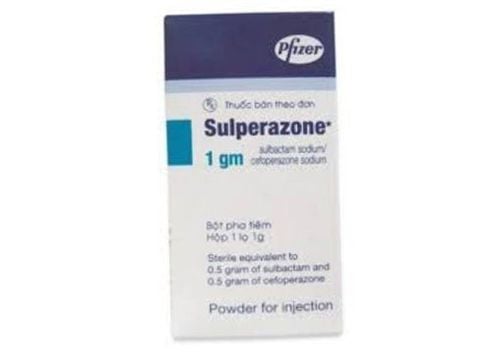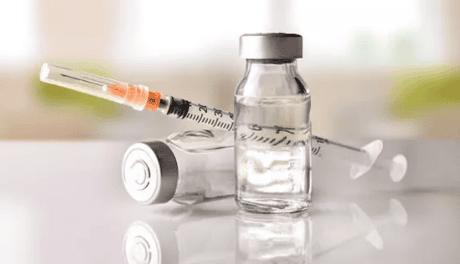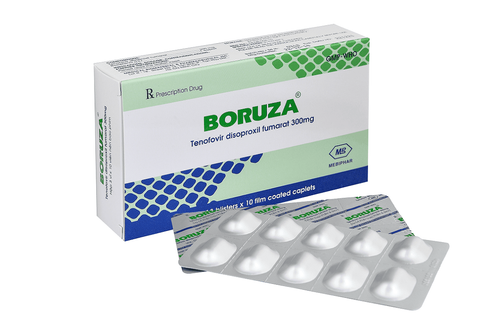This is an automatically translated article.
Klonaxol is an antiparasitic, antiviral and anti-infective drug. Cefoperazone is the active ingredient in the drug. What precautions should be taken when using Klonaxol? Let's find out information about Klonaxol drug through the article below.
1. What is Klonaxol?
Klonaxol belongs to the group of drugs used to treat parasites, anti-infectives, antivirals and antifungals. The drug is indicated for the treatment of patients with bacterial or viral infections.Klonaxol contains the main active ingredient Cefoperazone 1g (in the form of Cefoperazone sodium), which is prepared in the form of a powder for injection and infusion. Packing in box form of 1 vial, 10 vials.
2. What effect does Klonaxol have?
What does Klonaxol do? The main active ingredient Cefoperazone in the drug Klonaxol is a third generation Cephalosporin antibiotic. This substance is active against sensitive bacteria in the phase of duplication activity, inhibits the biosynthesis of mucopeptides of the cell wall. Cefoperazone is active against a broad spectrum of gram-negative bacteria.Klonaxol is indicated for the treatment of infections caused by the following susceptible organisms:
Respiratory tract infections including upper and lower respiratory tract infections. Urinary tract infections (upper and lower). Peritonitis, cholecystitis, cholangitis and other intra-abdominal infections. Peritonitis, bacteremia, purulent meningitis. Skin and soft tissue infections. Bone and joint infections. Pelvic inflammatory disease, endometritis , gonorrhea and other genital tract infections. Cefoperazone may be indicated for the prophylaxis of postoperative infections in surgical and gynecological, cardiovascular and orthopedic surgery patients.
3. How to use Klonaxol
3.1. How to use Klonaxol: For Klonaxol, patients use intravenous injection.
The drug formulation must strictly follow the instructions for use and instructions of the treating doctor. Each vial of Cefoperazone containing 1 or 2 g must be diluted in a volume of 20 to 100 ml of compatible sterile intravenous infusion solution and administered by drip over 15 minutes to 1 hour. If the solvent is sterile distilled water, do not add more than 20 ml of solution to the vial.
3.2. Dosage of Klonaxol Dosage varies according to the severity of the infection and the general health of the patient. Dosage for each indication is as follows:
Adults: Recommended dosage for mild to moderate infections 1-2g/12 hours. Severe infections 4g/12 hours. Adults with uncomplicated gonococcal urethritis: 500mg, as a single dose. Neonates and children: 50 - 200mg/kg/day, divided into 2 - 4 times. Meningitis patients can be increased to 300mg/kg/day in 2-4 divided doses. Patients with renal impairment: Recommended maximum dose of 4g/day. Dosage information is for reference only. To be able to use it most accurately, patients need to consult a specialist pharmacist or treating doctor.
3.3. Treatment of Overdosage Overdose: For Klonaxol overdose, the literature shows no specific antidote, treatment in case of overdose is symptomatic. If any incident of overdose or poisoning occurs, notify your doctor immediately or seek medical attention at the nearest hospital or poison control center. Family members should bring a medical record, including all prescriptions that have been and are being used so that the doctor can quickly diagnose and treat.
3.4. Klonaxol is contraindicated in the following cases:
Patients with hypersensitivity to the active ingredient Cefoperazone, or a history of allergy to the Cephalosporin group of antibiotics. Careful assessment and benefit/risk comparison should be made in the presence of the following: Bleeding disorders, gastrointestinal disease, especially ulcerative colitis, regional enteritis, liver disease.
4. Notes when using the drug Klonaxol
4.1. Special precautions and precautions for the use of Klonaxol In patients with known hypersensitivity to penicillins: If an allergic reaction occurs, the patient should discontinue the drug and initiate appropriate therapy. In patients with severe hepatic impairment or concomitant renal impairment: Serum cefoperazone levels should be checked and dose adjusted accordingly for each phase, under strict monitoring. Use in Children: Klonaxol has not been extensively studied for use in premature infants and neonates. Therefore, the physician needs to evaluate the benefits/risks of using the product. Pregnancy: Cefoperazone should be avoided during pregnancy. Lactation: Cefoperazone is excreted in small amounts in breast milk, so the risks and benefits to mother and baby should be carefully weighed. Do not self-medicate without your doctor's permission. Prolonged use of Klonaxol may lead to overgrowth of resistant bacteria. It is necessary to warn patients not to drink alcoholic beverages, to avoid the occurrence of headache reactions, tachycardia. In all types of infections: When treating infections caused by Streptococcus pyogenes, treatment should be continued for a minimum of 10 days. This product must be used under the strict supervision of a physician and cannot be re-purchased without a new prescription. 4.2. Side effects when using Klonaxol When using Klonaxol, you may encounter the following unwanted side effects:
Skin hypersensitivity: papulic rash, urticaria, more often occurs in patients with atopic Allergic reactions, especially to penicillins. On hematology: Leukopenia (mildly and reversible), hypoprothrombinemia (uncommon and transient). On the liver: Increased liver enzymes. On the digestive tract: Diarrhea, loose stools, of mild and moderate severity. Injection site reaction: Phlebitis. Other: Severe colitis, interstitial pneumonia and shock. 4.3.Interactions, drug incompatibilities Klonaxol should not be mixed Cefoperazone with aminoglycoside antibiotics directly, because it may increase the risk of nephrotoxicity, because there is a physical incompatibility between them. Concomitant use of Cefoperazone with coumarin or indandion-derivative anticoagulant products, heparin or thrombolytics may increase the risk of bleeding. Be careful when using Klonaxol with alcohol, alcoholic or fermented beverages, tobacco. Factors that can change the composition of the drug. Store Klonaxol medicine: Store the medicine at a temperature below 30°C, in the original packaging, avoid direct sunlight, avoid moisture, keep in a cool and dry place.
Above is all necessary information when using Klonaxol. Klonaxol is a prescription drug, so patients should not take it on their own and stop taking it without the permission of the treating doctor.
Follow Vinmec International General Hospital website to get more health, nutrition and beauty information to protect the health of yourself and your loved ones in your family.
Please dial HOTLINE for more information or register for an appointment HERE. Download MyVinmec app to make appointments faster and to manage your bookings easily.













